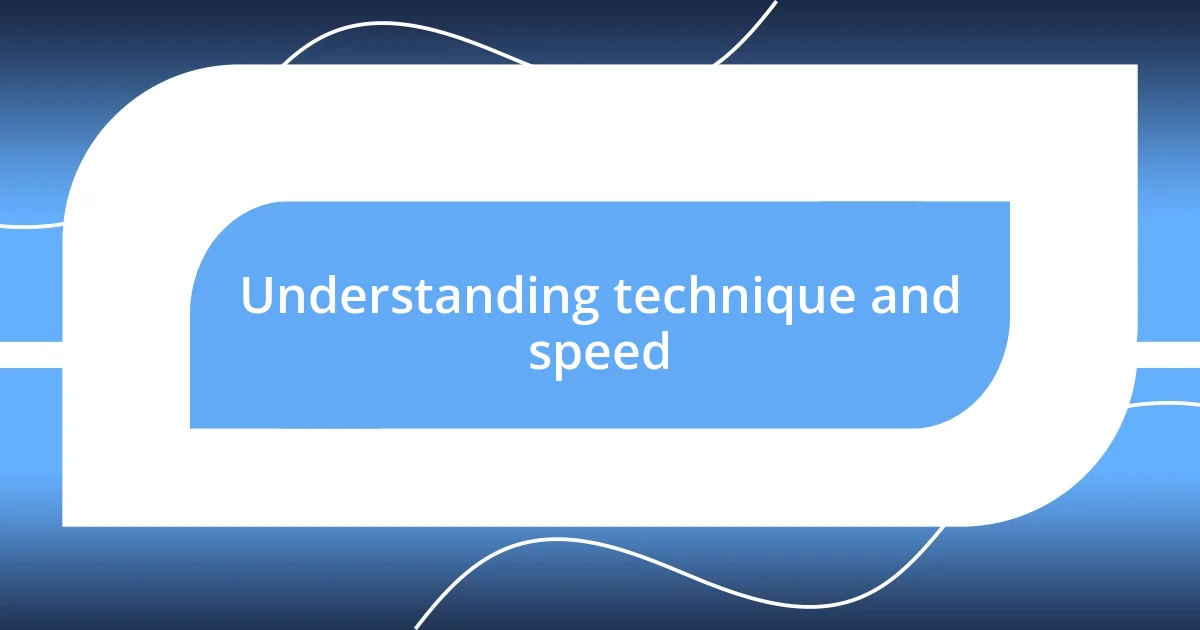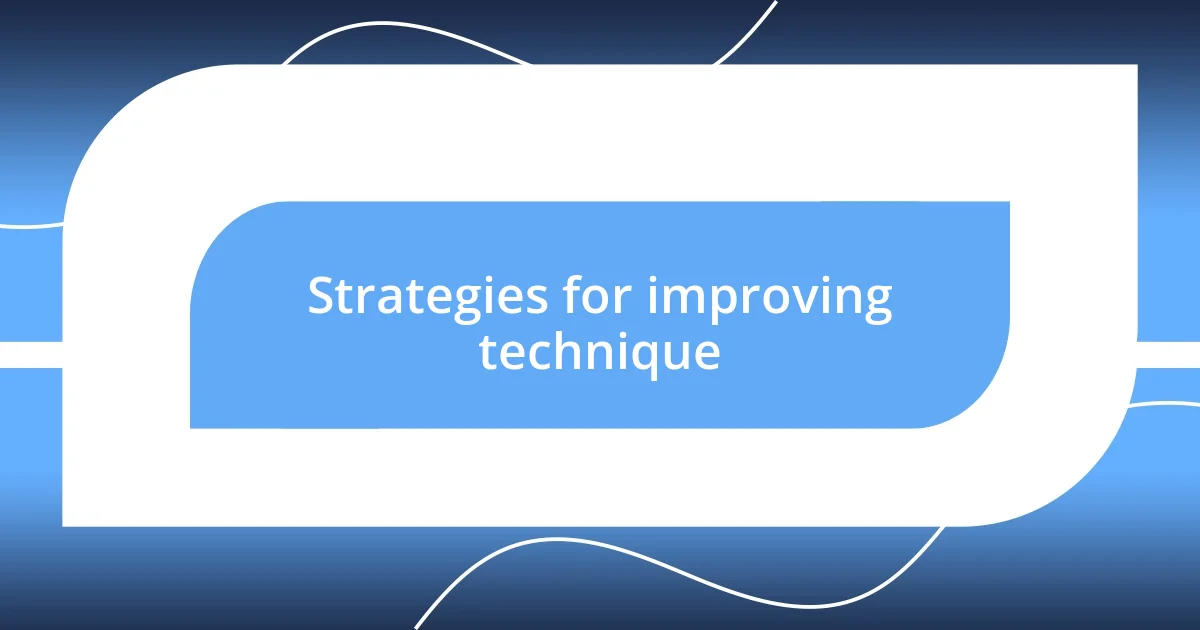Key takeaways:
- Technique and speed can coexist; intentionality in blending leads to better results.
- Assessing and reflecting on blending techniques, such as through self-recording or journaling, enhances skill and motivation.
- Maintaining a balance between technique and speed fosters a more enjoyable and effective blending experience.

Understanding technique and speed
Technique and speed are often seen as opposing forces, but I believe they can coexist beautifully. For example, when I first started blending my favorite smoothies, I would rush through the process. I quickly realized that if I didn’t focus on the right technique—like layering the ingredients for optimal blending—I ended up with a lumpy mix instead of a creamy delight. Isn’t it fascinating how a little mindfulness can significantly impact the end result?
As I’ve learned more about blending techniques, I’ve discovered that intentionality plays a crucial role in achieving speed without sacrificing quality. There have been countless times when I’ve been pressed for time but chose to slow down and really work through the blending process. I now understand that a few extra seconds spent layering or adjusting my speed settings on the blender can mean the difference between a mediocre texture and a silky smooth finish. Have you ever experienced that moment when you realize the impact of a small change?
Furthermore, mastering a technique often leads to a natural increase in speed over time. I remember when I first attempted to whip up one of my signature recipes. Each repetition felt painfully slow, almost like I was rehearsing a dance I hadn’t quite memorized. But with practice, I found my rhythm. My hands became quicker with every blend, and suddenly, what once felt awkward became second nature. It’s a reminder that sometimes, embracing the learning curve can yield surprising efficiency.

Assessing your current technique
Assessing your current technique is crucial for improvement. When I evaluate my blending skills, I often reflect on my past experiences. I recall one time when I was in a rush and didn’t pay attention to my angle when pouring ingredients into the blender. The mess that ensued not only wasted ingredients but also left me feeling frustrated. It’s essential to identify those moments where technique falters to avoid them in the future.
Often, it helps to film yourself during blending sessions. Watching the playback provides insights that are easy to overlook in the heat of the moment. I remember being surprised by how my posture affected my movements; I was hunched over, which slowed me down. After I corrected my stance, I noticed a significant boost in both speed and precision. Are you aware of how your body position might affect your overall blending technique?
Lastly, keeping a blending journal can be a game-changer. I started jotting down notes after each blending session, detailing what worked well and what didn’t. This habit allowed me to track my progress over time. Seeing my improvement written down reminded me of my journey and served as motivation. The intersections of my thoughts and techniques became clearer, paving the way for a more streamlined approach to blending.
| Assessment Method | Benefits |
|---|---|
| Self-Reflection | Identifies faults and areas for improvement |
| Video Review | Provides visual insights into technique |
| Blending Journal | Tracks progress and enhances motivation |

Strategies for improving technique
Improving blending technique requires a mix of practice, reflection, and mindfulness. I once experimented with different blenders to see how each unit affected my technique. I discovered that some blenders had unique features like pulse settings that allowed me to master a smoother blend by giving me more control. This taught me the importance of knowing my tools and the capability of each one; finding the right equipment can be a game-changer for technique.
To enhance your blending technique, consider these strategies:
- Focus on Ingredient Preparation: Take your time to chop or layer ingredients. This not only aids in blending but can also lead to better consistency in the final product.
- Experiment with Spin: Play around with the speed settings. I’ve found that gradually increasing the speed can create a better blend without splattering ingredients everywhere.
- Practice Rhythm: Blend in short bursts and listen to the sound of the blades. When I merged short bursts with my intuition, I could tell when to stop for a perfect texture.
- Engage Your Senses: Pay attention to the taste and smell of your blends as you go. I often pause mid-blending to taste, adjusting ingredients based on what I sense.
- Mindfulness in Movement: Stay aware of your body while blending. When I relaxed my shoulders and focused on my posture, I felt a notable increase in speed and fluidity.
Integrating these strategies into your practice can elevate your blending game, turning it from a chore into an enjoyable art form.

Enhancing speed through practice
Certainly! Here’s the revised content for “Enhancing speed through practice”:
When I first started blending, I felt like I was in a constant race against time. The more I practiced, the sharper my technique became. One evening, after a long day, I decided to challenge myself by timing my blending sessions. I was amazed to see that, as my hands became more familiar with the process, I naturally started moving faster. Isn’t it incredible how repetition can transform your abilities?
Incorporating drills into my practice made a huge difference. I once set aside a weekend to blend various ingredients at different speeds and durations, aiming for precision with each trial. It was fascinating to see how those focused sessions not only improved my speed but also enhanced the overall quality of my blends. Have you ever noticed how just a few dedicated hours can lead to a leap in your skill level?
Attending workshops further accelerated my blending journey. Watching seasoned professionals in action opened my eyes to new techniques I hadn’t considered. It reminded me that sometimes we need to step outside our comfort zone to truly see improvement. Do you have opportunities to learn from others? Engaging with peers and experts can add fresh perspectives that reinvigorate your practice.

Maintaining a balance in performance
Maintaining balance in performance is crucial for blending effectively. I remember a time when I was so focused on speed that I neglected my technique, resulting in a lumpy smoothie. It was a disappointment, but it taught me a valuable lesson: rushing compromises quality. Have you ever felt the same frustration when you prioritize one over the other?
Striking the right balance requires mindfulness and practice. Just last week, I experimented with blending while consciously slowing my pace, paying attention to texture and flavor in real-time. I found that allowing for small pauses to assess the blend made a significant difference. This intentional approach not only improved the quality of my blends but also made the process more enjoyable. How often do we miss the joy of blending because we’re too fixated on the end result?
Ultimately, it’s about understanding your rhythm. I still recall a blending session where I could feel my movements sync with the machine, creating a dance of sorts. This connection between technique and speed creates a harmonious flow. It’s fascinating how striking this balance can transform a simple task into a creative experience. Are you ready to find your rhythm?














